The film provoke a lot of emotions and feeling from me. I understand that it was illegal to cross the border from Mexico to the U.S.; but to mistreat and brutally kill anyone for violating the law is immoral. A pregnant woman was shot inside the chest without any remorse from the shooter; this incident really anger me. On the other hand; Machete kill in order to seek justice for the Latino people. He was not killing in vain. I admire Jessica Alba. Although she was a goverment official and stood for protecting the law; she had exercised her mind whenever it came to justice. She separated the law from Justice. Sometimes the law does not provide justice. There is the law then there is justice. Toward the end of the movie; I felt like justice was served.
Stand and Deliver (1988)

Stand and Deliver is a 1988 American drama film based on the true story of high school math teacher Jaime Escalante. Edward James Olmos portrayed Jaime Escalante. In the early 1980’s Jaime Escalante quit his middle class job to pursue a High School teaching career. He accepted a job at Garfield High School as a computer science teacher. Upon reporting to the job site he discovers there are no computers due to budget cuts and instead is assigned to teach a basic math class.
Garfield High School is located in East Los Angeles, the majority of the students are Latinos from low level income families. The school is gang infested. Jaime’s class is initially out of control, with humor and patience he manages to earn the respect of his students and begins to teach. “Ganas” is all anyone needs to succeed. Shortly thereafter Garfield undergoes the Accreditation review process. Administration is wary due to the low test scores of the school. Many of the Administrators have given up on the teens. They cite low test scores are a result of populations socioeconomic circumstance. Jaime sees the potential of his kids and offers to introduce Calculus to his students. “Students will rise to the levels of expectations.” Grudgingly administration agrees. Jaime taught math class through summer breaks, zero periods and after school to prepare his students for the Advanced Placement Calculus test.
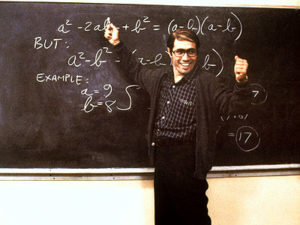
In 1982, 18 students took the test and passed.The students at Garfield High managed what many deemed impossible.The school in East Los Angeles had the highest passing rate in Southern California. However, the Educational Testing Services (ETS) questioned the results. An investigation was launched and the students were asked to retake the test. The dilemma, to retake or not to retake.That is the question.
Stand and Deliver is an inspirational movie. It is a movie directed and written by Latinos. I could argue that the movie depicted common stereotypes such as gangs and crime but it is a reality in the East Los Angeles neighborhood.The film stresses the importance of education to Chicano’s that are often judged by the color of their skin. As Escalante puts it”Math is the great equalizer.” According to Goldman “the representation of Chicano youths in Stand and Deliver challenges their image seen on dominant film and television. Perhaps more important, Stand and Deliver provides a more hopeful image of Chicano’s than many Chicano feature films of the eighties…” its a feel good movie for all but it touched me because I am a Chicana. Their success felt like my success. This film proves not all heroes wear capes.
“Ganas, all we need is Ganas” -Jaime Escalante
You are the true Dreamers, dreams accomplish wonderful things, you are the best”
-Jaime Escalante
Noriega, Chon A., and López, Ana M., eds. Ethnic Eye : Latino Media Arts. Minneapolis, MN, USA: University of Minnesota Press, 1996. ProQuest ebrary. Web. 12 May 2016.
Casa de Mi Padre (2012) EC

Armando Alvarez, played by Will Ferrell is the son of Miguel Ernesto Alvarez, played by Pedro Armendariz Jr, an esteemed ranch owner in the region where they reside. Armando’s younger brother Raul, played by Diego Luna, arrives at the ranch with his fiancé Sonia, played by Genesis Rodriguez. As the Alvarez’s ranch faces financial strains, the arrival of Raul puts Miguel at ease thinking he will be the ranch’s savior because Raul has become a successful business man. It turns out that Raul is in the business of drug trafficking and has arrived at the ranch with a mission to take control of that territory. La Onza, played by Gael Garcia who turns out to be Sonia’s repressive uncle and the leader of the drug cartel in that region. He is not pleased with Raul’s arrival, and seeks vengeance for Sonia’s capture. At the end the Alvarez family find themselves in a war with La Onza and his people and it’s all up to Armando to save the day.
Matt Piedmont created an American satire completely in Spanish. He explores every stereotype possible about Mexicans. With its melodramatic plot, he pokes fun of Latin telenovelas. Often over directing the scenes to mimic a Mexican soap opera. With Armando’s character he plays on the notion that Mexicans are people of the land and don’t understand complex themes or ideas. He goes as far as to having Armando sing a song that literally has the words ” I live a simple life, I am a friend of the cattle, I don’t know how to think, I’m just rancher”. Armando’s father epitomizes the Macho man figure of Mexico. Miguel Alvarez is proud of his younger son, Raul for being intelligent, financially successful, and having a beautiful fiancé. He is ashamed of Armando because he posses qualities that he considers too feminine. He even draws comparisons between Armando and his mother, saying he is dumb and too emotional like her. La Onza plays your stereotypical drug lord; he wears fancy clothes, throws extravagant parties with beautiful woman. He is ruthless and uses violence to intimidate.
La Casa de Mi Padre, is not only a comedy that makes fun of Americans’ clichéd views of Mexico, it also touches on the Mexico’s prime issue; the drug trade. While keeping a bizarre comedic approach, Piedmont is able to make a statement about the underlying problem of drug trafficking. Which in his opinion is the demand of drugs coming from the United States. In one of the most important scenes of the film, Armando confronts Raul about his unlawful business. Raul explains that he is only in the drug business because of the supply and demand from the U.S. He also discussed the issue of police corruption from both sides of the border. Drug Enforcement Administration (DEA) agent Parker, works together with the chief of the municipal police of that region to instigate a war between La Onza and Raul. Parker famously says, “Let them kill each other”.
This film only received two stars on rotten tomatoes and grossed eight million in the box office. A disappointing figure for a Will Ferrell movie. Let’s remember that this movie is entirely in Spanish. Even though, Will Ferrell has the star power, you have to be a dedicated fan to endure 84 minutes of him speaking Spanish. There’s not much a white audience can relate to in this film. In fact, this is where imaginative resistance takes place. As Flory explains in Imaginative Resistance, White Gaze in Machete and the Help, imaginative resistance is the unwillingness to suspend yourself from reality and imagine what the author of the fiction prompts. In this case it might be hard for the white audience to imagine what Piedmont is trying to say, because at first sight the movie might seem like a racist film making fun of the Mexican culture. But, we quickly get the sense that the white culture is the one that is being attacked. This is something that the white audience might be reluctant to accept. The over exaggeration of Mexican stereotypes suggest that the director thinks these views of Mexicans are ridiculous. The Latino community is used to being blamed for social and economic issues, however, Americans seem indignant when the blame is placed on them. In the end of the film, Armando tells the DEA agent that not all Mexicans are drug traffickers, in response the DEA agent says, not all Americans are bad. This suggests that there is a mutual understanding that there are cultural issues on both sides of the border.
Flory, Dan. The White Gaze and Machete
http://www.amazon.com/Casa-Padre-Blu-ray-Will-Ferrell/dp/B007L6VQ2W
(Must Watch)
Machete Kills (2013)
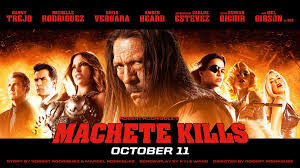
Machete kills – the sequel to the Mechete film we all viewed in class. The girls from the first movie Santana (Jessica Alba) and Luz (Michelle Rodriguez) have returned. As you remember Machete is a Federale. In Machete Kills the Mexican drug cartel is involved and its Machete’s mission to stop weapons suppliers selling to them. Dealing with law enforcement corruption Machete is taken by surprise of who he can trust. Charlie Sheen is the President of the US and cuts a deal with Machete. His services for in return US citizenship. In cohorts with the Mexican cartel is Marcos Mendez. A crazy man who is threatening to release a nuclear missile at the White House in Washington DC. He wants the American government to resist from trying to intervene with the Mexican government, the corrupt officials and the cartel.
Trying to find Marco, Machete meets new attractive women. They all seem attracted to him somehow. Rumors fly of how he handles women. With gun fights breaking out (without giving it away you’ll see lady gaga appear as a hot assassin. Machete is mis-guided with truest. After a gunfight he finds himself naturally Healy he is shown the operations of Mendez’s heart. He finds out his plans to detonate the nuclear weapon and to escape into space to rebuild his community.
With leading information, Machete is meets at the rendezvous point. This is wear he is ambushed and betrayed. Being shot and left to die, but Machete the super hero who never dies survives. He has special abilities to heal any wound. Deceit feels the mood and Machete notices an important killer. Without giving away who dies, a hint is its someone dear to him. As the missile launches Machete is there to save Washington DC from destruction.
The Ministers (2009)
Quinceanera (2006)

The film Quiceanera takes you on a 14 year old girls journey of finding out she is pregnant while preparing for her quiceanera. It demonstrates how Latino traditions have carried out in LA and the conflicts between generations here. The film connects the audience to the gentrification in Echo Park really well and demonstrates the heartbreak that families (mostly Latino) are going through in the area. Throughout the story the main character builds a strong relationship with her great uncle and gay cousin who seem to be the outcasts of the family.
The main character Magdalena gets pregnant at 14 even though she did not actually have sex with the boy, Herman. Her family is living comfortably in Echo Park with her dad being a pastor and the mom selling tamales. When her mom realizes what has happened she tells the father and he kicks Magdalena out of the house. She moves in with her uncle Thomas who sells champurrado in the neighborhood and has his own house with a big garden and his pet dogs. Her cousin Carlos already lives with Thomas because the family had basically disowned him for being a trouble maker and gay. Throughout the movie the 3 of them build a strong relationship because Carlos steps up to help with the baby and Magdalena is supportive of his lifestyle.
Carlos falls right in the center of the issues of gentrification within the movie, he finds himself in a mess with the gay white couple who moved in next door. They all admire him because he is like something exotic to them. At their house warming party, friends are constantly talking about how much the market has gone up there. Towards the end, the always happy uncle receives a heartbreaking notice of eviction. He loved his house and his garden and his dogs and even walking the neighborhood every day as the champurrado man. As an effect of gentrification, the family can not seem to find him anything that they can afford that isn’t tiny. The scene that really was heartbreaking is when he sits in his garden crying because the entire film he was such a happy man.
He died shortly after and in a way he died with his house. Many places in LA are undergoing gentrification and those being kicked out are mostly Latino. They cannot afford the extreme increases of the area and they are being forced out of their homes. Most families in Echo Park were getting buy with minimum wage jobs; families like the one in this movie. I could really relate to this movie because the uncle reminds me so much of my grandma. She lives in Anaheim in her house that she has had for almost 50 years and she has a big garden that has always been a part of her life. She loves her plants and taking care of them. She is pretty healthy for her age and keeps herself busy, all of the neighbors are also Latinas and they get together all the time and take walks or play cards. This film made me realize how this could happen to her especially since she lives right by Disneyland and it would devastate her just like the uncle. Health does go hand in hand with happiness it seems once someone has lost the will to live, they die.
This film is something most Latino people in LA can really identify with and enjoy. This is a quote of a part that made me laugh because I used to ask questions like this all the time as a little kid:
” Why is Tio Thomas eating worms?”
“It’s not worms it’s the fat from the meat.”
Under the Same Moon (2007)
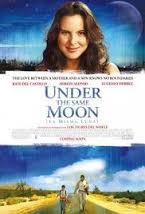
In the film, Under The Same Moon, Patricia Riggen tells the story of Carlitos, played by Adrian Alonso. A nine year-old Mexican boy who after the death of his grandmother, decides to cross the border to reunite with his mother who he hasn’t seen in four years. Rosario, Carlito’s mom is played by Kate del Castillo, emigrated to the United States in hopes to be able to provide a better future for her son. She works restlessly to save enough money bring her son to Los Angeles to live with her, but that dream seems to be far from the horizon and Carlitos can feel it. After his grandmother’s death, he is terrified that his oppressive uncle would obtain custody of him and decides to pay a couple of college students, who are in need of tuition money to cross him over to the United States (US). This is where his journey to find his mother in Los Angeles begins.
In Carlito’s journey to find his mom, he experiences the harsh realities of trying to survive in a foreign country. Although, his journey is roughly one week, he encounters the difficulties of a seasoned immigrant. Carlitos works in the fields picking fruit in the scourging heat surrounded by dangerous pesticides. He even has a run in with “La Migra,” who barges in the fields picking up every immigrant in sight. Luckily, Carlitos gets away but is left with no money forcing him to work odd jobs in a restaurant for very low wages. When arriving in Los Angeles, he has no money and has to settle for a night’s sleep in the park. Then we have Rosario, who works two housekeeping jobs to make ends meet for herself, her son and her mother on the other side of the border. Unable find a job after being fired without notice by her white employer, who mocks her by urging her to call police after she refuses to pay her for her last week’s work, she becomes desperate to get to Carlitos. This situation brings her to contemplate the idea of marrying her friend to change her legal Status. Despite having to endure such hardships, Carlitos and Rosario overcome adversity without losing their immigrant spirit.
In the middle of the 2016 presidential election, with a republican candidate who has ascended in the poles due to the anti-immigration policies he is pushing, I can’t help to think that the 2007 film Under the Same Moon came out in the wrong year. Immigration has been the central issue of this election. The American people want to know where the next potential President of the United States stands on this issue. Although Mexicans have been crossing the border for decades and in some instances recruited by the US for work. For example, the “Traqueros” who were Mexicans who were brought over to the US and trained to work at the railroads in the late 1800 to early 1900. This program was sponsored by US railroad companies but for some reason Mexican immigrants have just become a threat to our nation in recent years.
In the midst of all the fear mongering by the Trump campaign, by taking a few hours to watch this film it can change the negative perspective that many hold regarding undocumented immigrants. In The article The Boarder Crossed Us, Ingle describes the Latino Narrative Threat as “A Foucauldian discourse based on knowledge and power and the fear that occurs when one feel threatened by the “other”.” Trump is utilizing the Latino Threat Narrative to instill fear into the American people who are not familiar with the struggles immigrant workers face. This film depicts the hardships that undocumented families have to go through in order to escape poverty and violence in their native country and move to the US in search of a better life. In addition, the film touches on issues such as, family separation, low wages, job scarcity, civil rights violations, marriage fraud, and living in fear of Immigration and Naturalization Service.
In conclusion, contrary to the popular believe that immigrants come to the US to leach off our welfare system and take our jobs, Under The Same Moon shows us the opposite. It depicts the wearying struggle immigrant families face as soon as they cross the border. Carlitos and Rosario are not the stereotypical lazy Mexican; they are not afraid to work, often times working long hours for low pay. They also have a high level of morality. Rosario exhibits her morality by not going through with marrying her friend in order to change her immigration status. These characters have every good quality a US citizen should hold to make this country great again.
Ingle, Zachary “The Border Crossed Us”
Desperado
Desperado is a film directed by Robert Rodriguez. The definition of desperado is a desperate or reckless person. This especially describes a criminal, bandit or lawbreaker. Although this is the perfect name for the film, it is quite stereotypical that the cast for this move is completely portrayed by Mexican actors. The film follows El Mariachi who is played by Antonio Banderas, as he seeks revenge on a drug lord named Bucho (Joaquim de Almeida) for the death of his wife. It is a mercilessly violent movie that holds nothing back.
Every actor holds some stereotypical notion to their character’s identity. The bar owners are uneducated, dirty and are believed to urinate in their customers’ beers. They are also depicted as extremely hostile. In one scene, there are a group of Americans complaining about the service. One of the bartenders is quick to suggest that they shoot them. But the idea is dismissed.
El Mariachi epitomizes the idea of a machismo. He is tough, and dedicated to getting his revenge. In one scene, he even avoids bullets by simply walking away from them. He is certainly an extremely violent character. In the end, it is revealed that Bucho is actually El Mariachi’s brother. At first, he is reluctant to kill. But once Bucho gives El Mariachi an ultimatum that involves killing Carolina, El Mariachi has no choice but to kill his brother. This particular scene reminded me of American Me, and how the gang members would kill anyone to have a peace of mind or to be faithful to their gang. This idea of killing whomever to get to a certain position in life is a pervasive stereotype among Mexican Men.
Even Carolina, who is played by Salma Hayek, is a seemingly guiltless library owner. However, she is associated with drugs. She is one of the only female characters in a film surrounded by violent men. She also reminds me of the super-sexy typical Latina that is usually casted in Hollywood films. She has a Spanish accent and is constantly showing skin. Her tops are low-cut and her stomach is always revealed.
There is also a young boy who El Mariachi calls Nino that helps Bucho sell drugs. When El Mariachi furiously asks him what he gets from partaking in such activities, the young boy answers, “My father doesn’t have to work. He watches TV.” One can certainly say that this type of mentality demonstrated by his father is similar to the “lazy Mexican” notion.
Bucho, in my opinion, posses the most stereotypes that society commonly associate to Mexican men. For one, he a ruthless, trigger-happy, drug lord who has difficulties controlling his anger. In one particular scene, Bucho is furious after his team unsuccessfully kills El Mariachi. He states nonchalantly, “You drive around town, you see someone you know shoot them! How hard is that?” He then proceeds to demonstrate that exact scenario on one his members in his crew.
https://www.greenleft.org.au/node/10341
http://cevdetarkun.weebly.com/1/category/desperado/1.html
Mi Vida Loca (1993)

Mi Vida Loca or My Crazy Life a low budget independent film that was released in 1993. Ii was during in an era when gang brutality made news worthy stories and gang violence was at its peak. Many gang related killings are credited to this period. As gang tragedies intensify, they would become ordinary in these types of communities. Violence, drug abuse, and betrayal becomes a daily routine in communities such as Echo Park.In this film, the girls must battle between the odds that are not in their favor. This film is about survival in there twisted utopia.Their whole revolved around the neighborhood and the gang. This is a place where everything is at their convenience and there is no reason to leave since everything is there. It is a coming to age drama that revolves around the lives of two naive teenage female gang members Angel Aviles as Sad Girl and Seidy Lopez as Mousie. Jacob Vargas also co stars as Bullet the casanova of the ghetto.
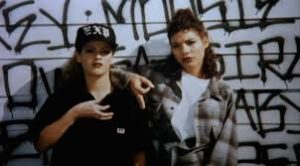
This film tells a story of two girls who were best friends andwho grew up in Echo Park, a small section of City of Los Angeles. The bond between the two girls is special and in a split second there lives are changed for ever. This film depicts the girls as vulnerable and lack the self respect as they both have a child from the same guy. They both have a child from Bullet. What was once a strong and unbreakable bond is now over. Sad Girl quotes “what comes around goes around that’s life in the Echo.
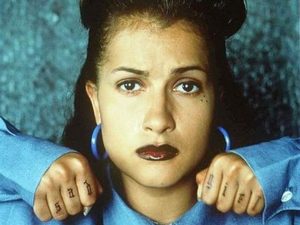
Dysfunctional families, outside influence and lack of common sense contribute to the girls bad choices. In the beginning of the movie, Mousie was hiding from her mom. As a little she was always getting into trouble. Mom is upset and call her daughter a bitch. Mousie at this time is about six years old. Unlike Real women Have Curves there is no strong family dynamics and family support that can actually be beneficial to a bright future. Sad to say, even the smart girl , Blue Eyes is gullible and is searching for romance through a prison pen pal. These girls are young but have had a rough life. Complacency and violence is a way of life for the female gang members. They do not take control of their lives because the gang life is the only priority. Motherhood at a young age is what is more important. As we see America Ferrera, she takes control of her sexuality and future by living the past to start something new.

As tension escalated between the two girls and a fight was inevitable, however, they actually never fought. Verbal confrontation and insults were a way these girls handled the situation. They would call each other fat to wetback, since Sad Girl was from Mexico, and because they were best friends at one time, they both new so much about each other. This is the away the two conveyed their animosity towards each other. They girls are both are being manipulated by Bullet. He is still sleeping with both of them and perpetuates the situation by doing so. They both are aware but feel that who ever he chooses, will get the ultimate prize. Bullet was a semi responsible father. He had a job but knew working at a grocery store is not going to be sufficient. He has to find a source of income that is easy and lucrative. He becomes a drug dealer just to support his children and his family. Bullet was a casanova and that led him to his demise. He was gunned down and murdered by a white women. This is nothing new when you choose a lifestyle that will ultimately led you to a prison sentence or death. Nothing productive can come from being in gang. This movie was Salma Hayek first film. It was the beginning of carrier for Jason Lee now both are famous thanks to a small independent film about life in the echo.
Beverly Hills Chihuahua (2008)

Beverly Hills Chihuahua is Disney movie that was released in 2008, and as you will see it is not only packed with Latino and white stereotypes, but it is also similar to the movies Born in East LA, and Real Women Have Curves. It is about a spoiled chihuahua from Beverly Hills named Chloe (Drew Barrymore). Chloe’s owner is a rich successful white woman named Viv (Jammie Lee Curtis). Viv is called away on business and she has her niece Rachelle (Piper Perabo) watch Chloe. Rachelle is a typical young adult who is very irresponsible, and according to Chloe can’t even hold a job. Rachelle ends up taking Chloe to Mexico and loses her. Chloe goes through a lot in this movie but in the end she is rescued with the help of admirer Papi (George Lopez) who is also a chihuahua. His Character is a little love struck Latino, who is always trying to get Chloe’s attention. Papi’s owner is Viv’s landscaper, Sam (Manol Cadona).
From this brief description you can already see the movie has it’s typical stereotypes. Viv a rich white woman from Beverly Hills, her niece is an irresponsible rich kid, her landscaper, or as Rachelle, and Chloe refer to him and Papi “just the gardener” is….you guessed it Latino!
As I previously mentioned the movie is similar to Born in East LA. In fact the plots are almost identical. Chloe’s character is much like Rudy’s (Cheech Marin). Chloe is technically Mexican American, since she is a chihuahua from Beverly Hills, and Rudy is also Mexican American. Both of these characters end up trapped in Mexico and their only goals is to get back home, and they face many struggles in trying to get back. While in Mexico Chloe is placed in a kennel with other dogs, and they begin to speak to her in Spanish, just as the passengers on the bus did to Rudy when he was being deported. Both characters say they do not speak Spanish and the rest of the group seems appalled. In the kennel one of the dogs asks Chloe “don’t you speak any Spanish?” She asks, “why would I?” And he replies “hello because you’re a chihuahua mija!!” This is a stereotype that many Latinos face, it is assumed because they are Latino they should know how to speak Spanish even if they were born and raised in America. To add to that stereotype it is sometimes assumed Latinos do not know how to speak English. This is also shown in both movies. In Beverly Hills Chihuahua Rachelle tells Sam to get Papi, but she assumes he does not speak English, and she attempts to to talk to him in some form of her own Spanglish. Sam does not correct her but later it is revealed he speaks perfect English. Rachelle gets upset that Sam “made” her look stupid by letting her think he only speaks Spanish and he points out she didn’t need any help from him. This also happens to Rudy a few times in the movie, for example when he speaks to the border patrol and when he first meets Jimmy. The white characters are shocked he speaks English so well.
This movie is not only similar to Born in East LA but it is also similar to Real Women Have Curves. Chloe and Ana (Amercia Ferrera) are similar in that they start off as bratty selfish characters who perhaps really do believe they are better than the other characters. However, as they spend more time with the other characters they begin to accept their culture and find a new appreciation for it. The same also happens to Rudy.
Another way the two films are similar are Chloe and Ana are empowered by the men in the film. Chloe is empowered by Montezuma (Placido Domingo) a little chihuahua warrior. He tells Chloe she is also a warrior and that chihuahuas should not stand for being little helpless lap dogs and they were not bred to be dressed up and carried in purses, but instead they are a mighty warrior breed who can do anything. In the end she transforms from a helpless little lap dog to a “warrior dog” who fights the evil doberman, El Diablo (Edward James Olmos), in order to help Papi and her friend Delgado (Andy Garcia). Ana’s teacher, Mr. Guzman (George Lopez)is somewhat of a Montezuma as he tells her she is smart and she can do anything she wants to do, and she should not waste it and not go to college. Ana also has somewhat of a fight with her mom who does not want her to go to college, but in the end Ana goes off to college.
I viewed the this film with my thirteen year old niece, and when it was over she asked, “so was this movie to show how Chloe accepted her Mexican culture?” I do think that is what not only this movie, but also Real Women Have Curves and Born in East LA aimed to do. To show how Mexican Americans are torn between two worlds and face stereotypes on both sides, and how they struggle to find and accept who they are.
